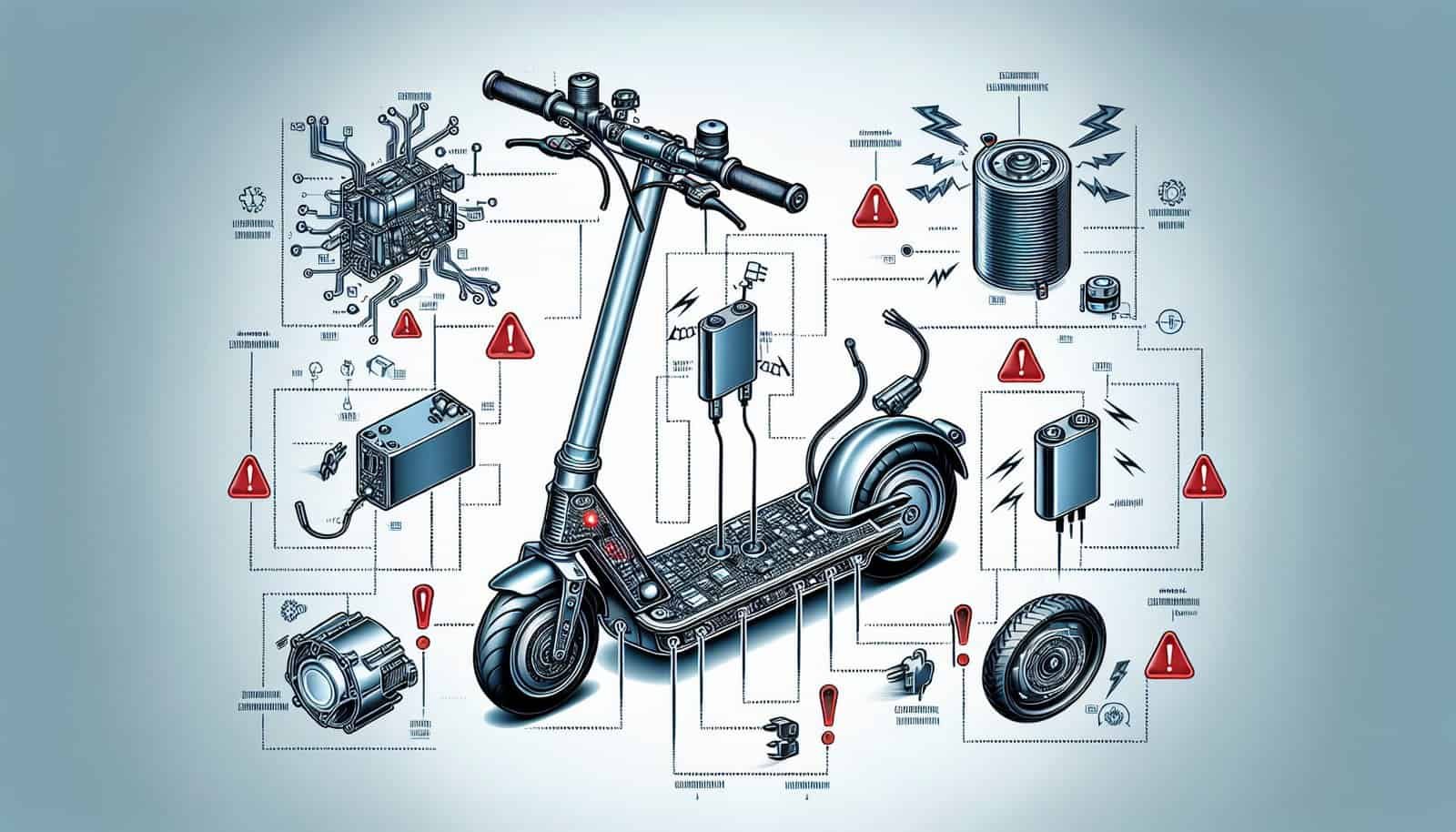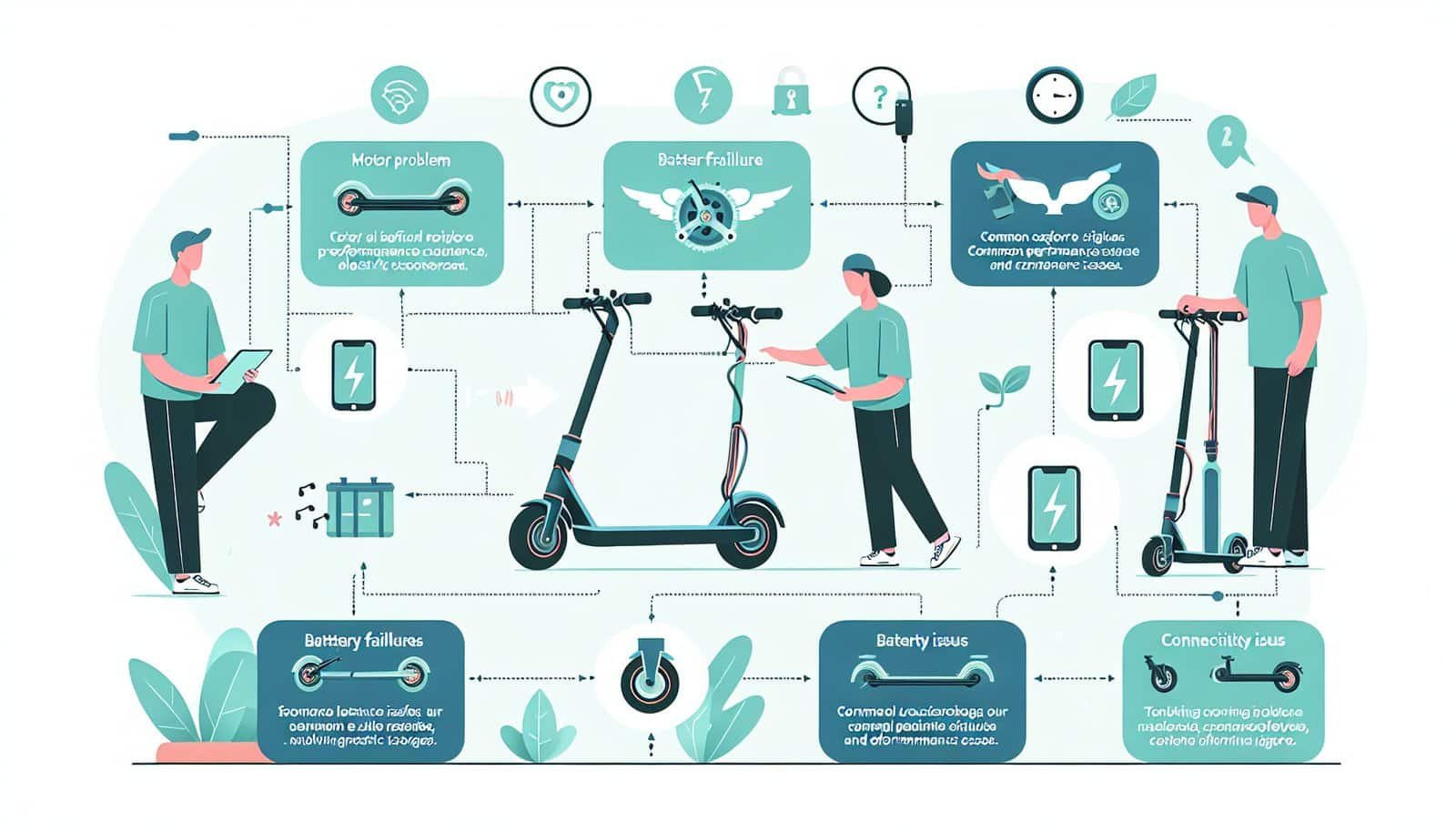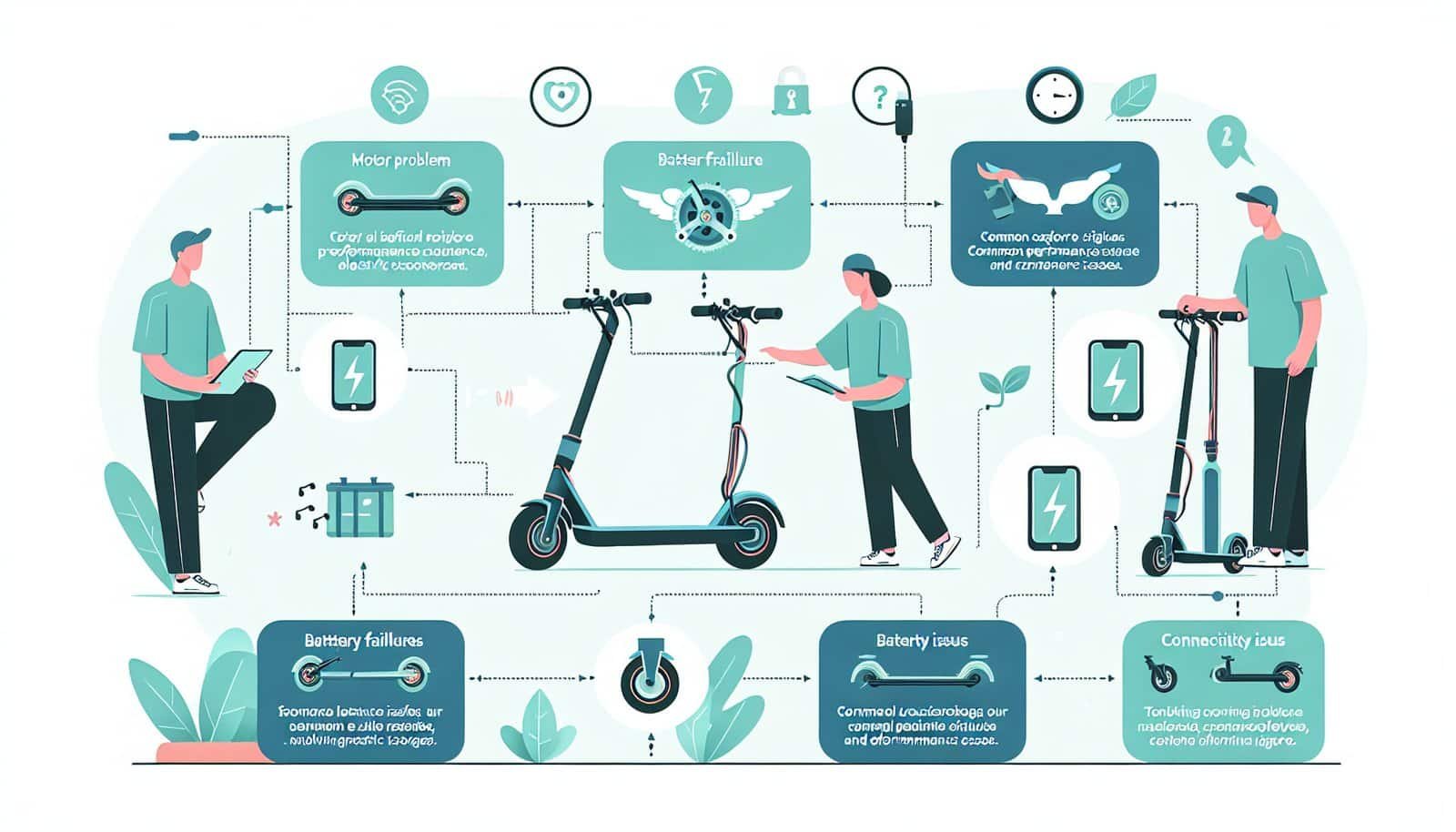Is your electric scooter not performing as well as it used to? Don’t worry, you’re not alone. Many electric scooter owners face common issues that affect their scooter’s performance. From declining battery life to trouble with acceleration, these problems can be frustrating. But fear not, because in this article, we’ll guide you through some simple troubleshooting steps to help you uncover the root cause of the issue and get your electric scooter back on track. So, let’s dive in and get your scooter running smoothly again!

Checking the Battery
Inspecting the Battery Connections
When troubleshooting common issues with your electric scooter’s performance, it’s important to start by checking the battery. Inspecting the battery connections is the first step in this process. Begin by locating the battery compartment and ensuring that it is securely closed. Open the compartment and visually examine the battery connections for any signs of corrosion or looseness. Corrosion can impede the flow of electricity and cause performance issues. If you notice any corrosion, use a clean cloth or brush to gently remove it. Additionally, ensure that all connections are tight and secure.
Testing the Battery Voltage
After inspecting the battery connections, the next step is to test the battery voltage. This will help determine if the battery is providing an adequate charge for optimal scooter performance. Start by turning off the scooter and disconnecting the battery from the charger, if it’s connected. Use a multimeter set to the DC voltage range and attach the positive (red) probe to the positive terminal of the battery and the negative (black) probe to the negative terminal. The multimeter should display the battery voltage. Compare this reading to the recommended voltage range specified by the manufacturer. If the voltage is significantly lower than the recommended range, it may be time to consider replacing the battery.
Checking for Battery Overheating
Battery overheating is a common issue that can negatively impact the performance of your electric scooter. To check for battery overheating, inspect the battery for any signs of excessive heat or swelling. If the battery feels excessively hot to the touch or appears abnormally swollen, it may be a sign of an underlying problem such as a faulty charger or a defective battery. In such cases, it’s important to stop using the scooter immediately and consult the manufacturer or a professional technician for further assistance. Continuing to use the scooter with an overheating battery can lead to safety hazards and further damage to the scooter’s components.
Verifying the Motor
Examining Motor Connections
The motor plays a crucial role in the performance of your electric scooter. If you’re experiencing issues with the scooter’s performance, it’s important to examine the motor connections. Locate the motor and inspect the connections for any signs of looseness or corrosion. Loose connections can cause poor electrical conductivity, leading to performance problems. If you notice any loose connections, carefully tighten them using the appropriate tools. Additionally, inspect the motor connections for signs of corrosion. Corrosion can impede electrical flow, affecting the motor’s performance. Use a clean cloth or brush to gently remove any corrosion, ensuring that the connections are clean and secure.
Testing Motor Performance
Once you’ve examined the motor connections, it’s time to test the motor performance. This will help determine if the motor is operating at its optimal level. Start by turning on the scooter and engaging the throttle. Observe the motor’s response. It should start smoothly and provide consistent power throughout the acceleration. Any hesitation, uneven performance, or unusual noise may indicate a problem with the motor. If you notice any irregularities, it’s advisable to contact the manufacturer or a professional technician for further assessment and potential repairs.
Inspecting Motor Brushes
Motor brushes are essential components that facilitate the flow of electricity within the motor. Over time, these brushes can wear down, leading to decreased performance. To inspect the motor brushes, you’ll need to locate them within the motor housing. Carefully remove the brush covers, if applicable, and visually examine the brushes for wear. If the brushes appear significantly worn down or damaged, they may need to be replaced. Consult the manufacturer’s guidelines or seek professional assistance to ensure proper replacement. Regularly inspecting and maintaining the motor brushes can help prolong the lifespan of your electric scooter’s motor.
Assessing the Controller
Inspecting Controller Connections
The controller is responsible for regulating the power flow from the battery to the motor, making it an important component to assess when troubleshooting performance issues. Start by locating the controller, which is typically located near the motor or battery compartment. Inspect the controller connections for any signs of looseness or corrosion. Loose connections can disrupt the flow of electricity and negatively impact the scooter’s performance. If you discover any loose connections, carefully tighten them using the appropriate tools. Additionally, check for any signs of corrosion and clean the connections if necessary.
Checking the Controller’s Functions
With the controller connections inspected, the next step is to check the controller’s functions. The controller regulates the speed and acceleration of the electric scooter, so it’s essential to ensure it’s functioning properly. Turn on the scooter and engage the throttle while observing the scooter’s performance. Ideally, the scooter should respond smoothly and accelerate seamlessly. Pay attention to any delays, jerky movements, or unresponsive behavior. If you notice any abnormalities, it may indicate a problem with the controller. In such cases, it’s best to contact the manufacturer or a professional technician for further diagnosis and potential repairs.
Resetting the Controller
If you’re experiencing performance issues with your electric scooter, resetting the controller may help resolve the problem. To reset the controller, start by turning off the scooter and disconnecting the battery. Wait for a few minutes before reconnecting the battery and turning on the scooter again. This process allows the controller to recalibrate and reset any potential software glitches. After resetting the controller, test the scooter’s performance to see if the issue has been resolved. If the problem persists, further troubleshooting or professional assistance may be necessary.
Examining the Wiring
Inspecting for Loose or Damaged Wires
Wiring issues can greatly impact the performance of your electric scooter. Start by visually inspecting the wiring for any signs of loose connections or damage. Ensure that all wires are securely connected and free from any fraying, exposed conductors, or cuts. Loose or damaged wires can disrupt the electrical flow and lead to performance issues. If you notice any issues with the wiring, it’s important to have it repaired or replaced by a professional technician to ensure the safety and optimal performance of your electric scooter.
Checking Wire Connections
In addition to inspecting for loose or damaged wires, it’s important to check the wire connections. Start by carefully examining each connection point, ensuring they are securely attached. Pay close attention to any signs of corrosion or loose connections. Corroded or loose wire connections can impede the flow of electricity, negatively impacting the scooter’s performance. If you notice any issues, clean the connections and tighten them as necessary to ensure optimal conductivity.
Testing Wire Continuity
Wire continuity refers to the smooth flow of electrical current through the wires. To test wire continuity, a multimeter can be used. Set the multimeter to the resistance or continuity mode and touch the probes to both ends of a wire segment. If the multimeter displays a low resistance or continuity reading, it indicates that the wire has good continuity. However, if the multimeter shows a high resistance or no continuity, it suggests that there is a break or fault in the wire. In such cases, the faulty wire segment may need to be repaired or replaced by a professional technician to restore the scooter’s performance.

Inspecting the Throttle
Verifying Throttle Connectivity
The throttle is a critical component that allows you to control the speed and acceleration of your electric scooter. When troubleshooting performance issues, it’s essential to verify the throttle connectivity. Start by locating the throttle unit on the handlebars. Inspect the connections between the throttle unit and the scooter’s control panel for any signs of looseness or damage. Ensure that all wires are securely connected and free from any damage or corrosion. Loose or damaged connections can result in unresponsive or erratic throttle behavior. If you notice any issues, consult the manufacturer’s guidelines or seek professional assistance to ensure the proper repair or replacement of the throttle unit.
Checking Throttle Calibration
Throttle calibration ensures that the scooter responds accurately to your control inputs. If you’re experiencing performance issues, it’s worth checking the throttle calibration. Start by turning on the scooter and ensuring it is in the normal operating mode. Turn the throttle to the maximum position and hold it there for a few seconds. Slowly release the throttle back to the idle position. This procedure helps calibrate the throttle and ensures that the scooter interprets your commands accurately. After performing the calibration, test the scooter’s performance to see if the issue has been resolved. If the problem persists, further troubleshooting or professional assistance may be necessary.
Inspecting Throttle Components
Within the throttle unit, there are various components that contribute to its functionality. When troubleshooting performance issues, it’s important to inspect these components. Carefully open the throttle unit and visually examine the inner mechanisms, such as the throttle potentiometer or Hall effect sensor. Look for any signs of damage, wear, or debris that may affect the throttle’s performance. Clean any debris or dust that may have accumulated, ensuring that the components are free from obstructions. If you notice any significant damage or wear, consider consulting the manufacturer’s guidelines or seeking professional assistance for potential repairs or replacements.
Testing the Brake System
Inspecting Brake Connections
The brake system is a critical safety feature of your electric scooter. To ensure optimal performance and safety, it’s important to inspect the brake connections regularly. Start by locating the brake components, such as the brake levers or brake discs. Visually inspect the connections between the brake levers and the control panel. Ensure that all wires are securely connected and free from any damage or corrosion. Loose or damaged connections can result in poor brake responsiveness, compromising your safety. If you notice any issues with the brake connections, consult the manufacturer’s guidelines or seek professional assistance to ensure the proper repair or replacement of the brake components.
Checking Brake Fluid Level
If your electric scooter is equipped with a hydraulic brake system, it’s important to check the brake fluid level. Low brake fluid can lead to decreased braking performance. Consult the manufacturer’s guidelines to locate the brake fluid reservoir. Open the reservoir cap and visually inspect the fluid level. If the fluid level is below the minimum mark, it’s necessary to add brake fluid to the appropriate level. Use the recommended brake fluid specified by the manufacturer and ensure that you follow the proper procedures for adding brake fluid to your scooter.
Testing Brake Performance
After inspecting the brake connections and checking the brake fluid level, it’s crucial to test the brake performance. Ensure that you are in a safe and open area before conducting the test. Start by engaging the brake levers and applying pressure gradually. The brakes should engage smoothly and bring the scooter to a controlled stop. If you experience any issues, such as delayed or weak braking, it’s important to address them promptly. Consult the manufacturer’s guidelines or seek professional assistance to diagnose and resolve any brake performance problems. Properly functioning brakes are essential for your safety while riding the electric scooter.

Examining the Tires
Checking Tire Pressure
Tire pressure is a key factor in maintaining the performance and safety of your electric scooter. Start by locating the tire valves and use a tire pressure gauge to check the pressure. Inflate or deflate the tires as necessary to meet the recommended pressure specified by the manufacturer. Proper tire pressure ensures optimal traction, stability, and maneuverability while riding the scooter. Riding with underinflated or overinflated tires can lead to decreased performance and pose safety risks. Regularly check the tire pressure and maintain it within the recommended range for optimal scooter performance.
Inspecting for Damage or Wear
Checking for damage or wear in the scooter’s tires is crucial for maintaining performance and ensuring safety. Inspect the tires for any signs of cuts, punctures, or significant wear. Cuts or punctures can lead to tire deflation or compromised traction, while excessive wear can affect the scooter’s handling and stability. If you notice any significant damage or wear, it’s important to replace the tires promptly. Consult the manufacturer’s guidelines or seek professional assistance to ensure the proper selection and installation of new tires for your electric scooter.
Testing Tire Traction
Tire traction is essential for maintaining control and stability while riding your electric scooter. To test tire traction, find an open and safe area, free from any obstacles or hazards. Start by riding the scooter at a moderate speed and gradually apply the brakes. Observe how the scooter responds to braking and assess if the tires provide sufficient grip and traction. If you notice any issues, such as skidding or slipping, it may indicate a problem with the tires’ traction. In such cases, consult the manufacturer’s guidelines or seek professional assistance to diagnose and address any tire traction issues.
Assessing the Suspension
Inspecting Suspension Components
The suspension system of your electric scooter plays a vital role in absorbing shocks and vibrations, ensuring a comfortable ride. Start by visually inspecting the suspension components, such as the forks or shock absorbers. Look for any signs of damage, such as leaks or excessive wear. Pay close attention to the connection points, ensuring they are securely attached and free from any looseness or corrosion. Loose or damaged suspension components can lead to decreased performance and discomfort while riding. If you notice any issues, consult the manufacturer’s guidelines or seek professional assistance for proper inspection, adjustment, or replacement of the suspension components.
Checking for Suspension Misalignment
Suspension misalignment can negatively affect the scooter’s stability and handling. To check for suspension misalignment, start by placing the scooter on a flat and level surface. Observe the scooter from a distance, ensuring that it sits evenly. If you notice any visible tilting or asymmetry, it may indicate a misalignment in the suspension. In such cases, it’s advisable to consult the manufacturer’s guidelines or seek professional assistance to diagnose and address any suspension alignment problems. Proper alignment ensures optimal performance, safety, and rider comfort.
Testing Suspension Performance
To assess the suspension performance of your electric scooter, take it for a test ride on various terrains. The scooter should provide a smooth and comfortable ride, effectively absorbing bumps and vibrations. Pay attention to any excessive bouncing, uncomfortable vibrations, or unusual noises. These may indicate issues with the suspension system. If you notice any problems, consult the manufacturer’s guidelines or seek professional assistance to diagnose and resolve any suspension performance issues. Regularly maintaining and addressing suspension concerns will help ensure a safe and enjoyable riding experience.

Cleaning and Lubricating
Cleaning and Inspecting Electrical Components
Regularly cleaning and inspecting the electrical components of your electric scooter is essential for maintaining optimal performance and prolonging the lifespan of the scooter. Start by turning off the scooter and disconnecting the battery. Use a clean and dry cloth to gently remove any dust, dirt, or debris from the electrical components, such as the battery connections, motor connections, and controller connections. Inspect the components for any signs of corrosion, damage, or loose connections. If you notice any issues, consult the manufacturer’s guidelines or seek professional assistance to address them appropriately. Keeping the electrical components clean and well-maintained will contribute to the overall performance and reliability of your electric scooter.
Lubricating Moving Parts
Lubricating the moving parts of your electric scooter is crucial for smooth operation and preventing premature wear. Start by identifying the moving parts, such as the motor bearings, suspension components, or folding mechanisms. Consult the manufacturer’s guidelines to determine the appropriate lubricant for each component. Apply a small amount of lubricant to each moving part, ensuring that it is evenly distributed. Avoid over-lubricating, as excess lubricant can lead to accumulation of dirt and debris. Regularly lubricating the moving parts will help reduce friction, noise, and wear, contributing to the overall performance and longevity of your electric scooter.
Removing Debris and Obstructions
Debris and obstructions can hinder the performance and functionality of your electric scooter. Regularly inspect and remove any debris or obstructions from the scooter’s components, such as the wheels, brakes, or motor. Pay close attention to the wheel wells, where small rocks or debris may become lodged. Clear any obstructions that may affect the scooter’s movement or interfere with its components. Additionally, ensure that the scooter’s air vents or cooling mechanisms are free from dust, dirt, or obstructions. Regular maintenance and debris removal will help maintain optimal performance and prevent potential damage to your electric scooter.
Performing Firmware Updates
Checking for Firmware Updates
Firmware updates are essential for ensuring the latest features, bug fixes, and performance enhancements on your electric scooter. Start by visiting the manufacturer’s website or consulting the user manual to check for any available firmware updates. Follow the instructions provided by the manufacturer to determine if an update is necessary for your scooter model. Firmware updates can address performance issues and enhance the overall functionality of your electric scooter, so it’s important to stay up to date with the latest releases.
Updating the Scooter’s Software
To update the software of your electric scooter, follow the manufacturer’s instructions provided with the firmware update. Typically, this involves connecting the scooter to a computer or mobile device using the appropriate cable or wireless connection. Follow the on-screen prompts and guidelines to initiate the software update process. It’s important to ensure that the scooter’s battery is sufficiently charged and that you have a stable internet connection throughout the update process. Avoid interrupting the update or disconnecting the scooter during the software update. After completing the update, test the scooter’s performance to ensure that the update has addressed any previously experienced issues.
Resetting the Scooter’s Settings
If you’re still experiencing performance issues after completing the troubleshooting steps, resetting the scooter’s settings may help resolve the problem. Start by referring to the manufacturer’s guidelines or user manual to locate the reset button or procedure for your specific scooter model. Follow the instructions provided to initiate the reset process. Resetting the scooter’s settings will revert them to their default configurations, potentially resolving any software or configuration-related issues. It’s important to note that resetting the settings may erase any personalized configurations or preferences, so it’s advisable to take note of your desired settings or configurations before proceeding. After resetting the scooter’s settings, test its performance to see if the issue has been resolved. If the problem persists, contacting the manufacturer or a professional technician may be necessary for further troubleshooting or repairs.
By following these comprehensive troubleshooting steps, you can address common performance issues with your electric scooter effectively. Remember to consult the manufacturer’s guidelines and seek professional assistance when necessary. Regular maintenance, inspections, and firmware updates play key roles in ensuring the optimal performance, safety, and longevity of your electric scooter. Happy riding!


